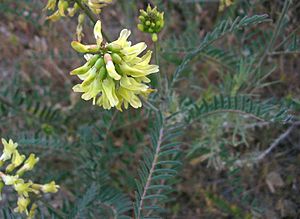Santa Barbara milk vetch facts for kids
Quick facts for kids Astragalus trichopodus |
|
|---|---|
 |
|
| Conservation status | |
| Scientific classification |
Astragalus trichopodus, also known as the Santa Barbara milk vetch, is a type of legume plant. Legumes are plants that produce their seeds in pods, like peas or beans. This plant naturally grows in southern California and Baja California in Mexico. You can find it in different open areas, including the Transverse Ranges and the Mojave Desert.
Contents
What is the Santa Barbara Milk Vetch?
The Santa Barbara milk vetch is a strong plant that lives for many years. It is called a perennial herb. Its stems can grow up to about one meter (about 3 feet) tall and branch out.
Leaves and Flowers
The plant's hairy stems have many leaves. Each leaf can be up to 20 centimeters (about 8 inches) long. They are made of several pairs of small, pointed leaflets. Each leaflet is about 2.5 centimeters (1 inch) long.
The flowers grow in a cluster called a raceme. A raceme is a type of flower cluster where the flowers grow along a central stem. There can be up to 50 flowers in one cluster. The flowers are usually cream-colored, but sometimes they have a light purple tint. Each flower is about 2 to 3 centimeters (about 1 inch) long. This length includes its tube-shaped base, which is made of leaf-like parts called sepals.
How Does It Reproduce?
After the flowers bloom, they turn into fruits. The fruit of the Santa Barbara milk vetch is a pod. This pod is a type of legume pod, similar to a pea pod. It is somewhat flat and slightly puffy. The pods can grow up to 4 to 5 centimeters (about 2 inches) long.
When the pods dry out, they become thin and feel like paper. They hang in bunches from where the flowers used to be. Each pod holds many seeds inside. These seeds will grow into new plants if they find the right conditions.
Images for kids



